Abstract
Objectives: Pronounced wound healing responses induced by phenytoin in inflamed gingivae have potential for matrix regeneration in this context. It enhances matrix formation in tissues and impairs their breakdown. The matrixregenerative responses of human periosteal fibroblasts to phenytoin and histamine were studied using the metabolite 5 alpha- dihydrotestosterone (DHT) as a marker of inflammatory wound repair; derived from 14C-testosterone and 14C-4- androstenedione as independent substrates in order to ascertain metabolic responses. Methods: Confluent monolayer cultures of human periosteal fibroblasts of the 5th-9th passage from eight subjects were incubated individually in 24-well multiwell plates in Eagle’s MEM. Independent incubations were performed with each of the substrates 14C-T and 14C-4- A, with optimal concentrations of histamine (H; 8μg/ml) and phenytoin at 1(Ph1) and 5μg/ml (Ph5) alone and in combination (H+Ph1; H+Ph5). Following 24h incubation the eluent was prepared for TLC in a benzene. Acetone solvent system (4:1) for the separation of metabolites. They were quantified using a radioisotope scanner. Results: The substrates a.14CT and b.14C-4A were metabolized to DHT, diol and 4-A or T respectively. With each substrate, yields of DHT were significantly increased over controls in response to H (a.74%; b.2.3-fold), Ph1, 5 (a.70%, 2-fold;b. 2.8-,1.9-fold) and the combinations (a.60%; b.2-fold and 73%), respectively (n = 8; p < 0.01/0.001). There were also significant increases in the yields of diol and T respectively in response to agents tested. Conclusion: Significant increases in yields of DHT in response to Ph and H with both substrates indicate their anabolic potential in periosteal fibroblasts. This has implications for diverse applications in tissue repair in an inflammatory environment. Patents relevant to matrix synthesis and its modulation by microRNAs during inflammatory healing responses have been discussed.
Keywords: Biomarkers, histamine, inflammation, periosteal fibroblasts, phenytoin, wound repair.
 13
13

